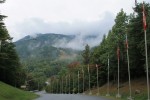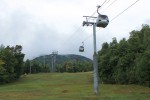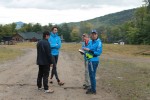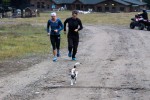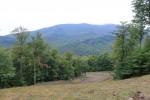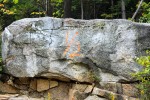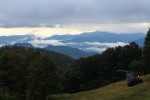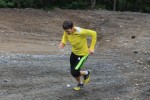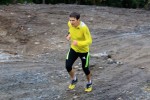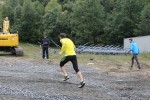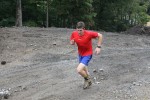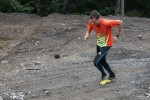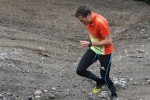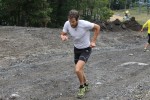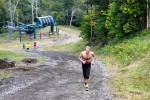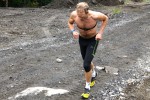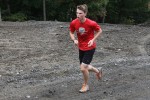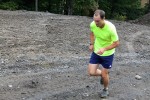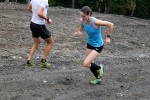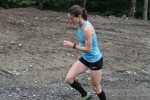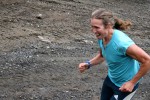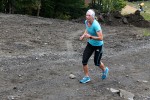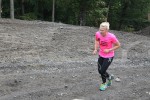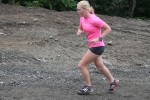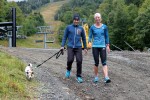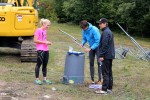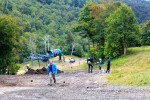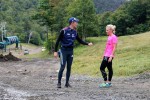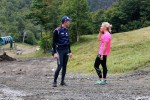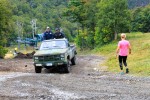
WILMINGTON, N.Y. — “You know we do other workouts,” Tim Burke says with a laugh more than halfway up the 4,867-foot Whiteface Mountain. Minutes before, the 32-year-old U.S. biathlete completed his big effort of the day in 13 minutes, 21 seconds, finishing about 1,300 feet higher than he started on Tuesday.
In doing so, Burke set a new time to beat in the third edition of the Tim Burke Uphill Run Test (TBURT), named after him because he mapped the route a few months earlier. U.S. Biathlon (USBA) teammate Russell Currier was just four seconds off his mark for the second-fastest time on Tuesday, and USBA Talent ID recruit Max Durtschi was another four seconds back in third.
“This is my second time doing it all out, and it was just as painful as the first,” Burke said near the top of Whiteface’s Face Lift on a 50-degree morning with 100-percent humidity.
The run ended nearby at the base of the Summit Quad, and while it didn’t rain, the course was muddier than usual with several construction vehicles sharing the trails.
“This is my second time doing it all out, and it was just as painful as the first.” — Tim Burke on the Tim Burke Uphill Run Test
“It’s a great climb to get you up to your max heart rate,” he added. “It’s pretty quick and then you have to hold it. It’s not too long so endurance really doesn’t come into play; it’s more of just a max test.”
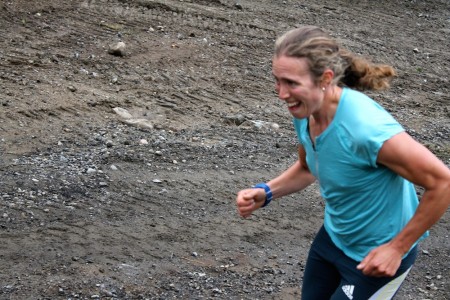
Whiteface is New York’s fifth-highest mountain and earlier this month, Burke was the fastest to ascend it on rollerskis in the annual Climb to the Castle.
In June, aspiring biathletes at the USBA tryout camp ran the route for the first time, with Durtschi posting the best time of 13:56. Five of those athletes returned a couple weeks ago to run it again.
On Tuesday, 13 athletes at the two-week, USBA national-team camp, between the A, B, development and X teams and Talent ID crew, pushed up it once more.
“There’s no real variables,” Burke said of the test’s advantages, compared to say, rollerskiing, which can be affected by temperatures and different ski speeds. “Today, it was a little bit muddier than it was in the past, but I don’t think it really slowed the times down.”
To the surprise of four USBA coaches present, everybody’s time was faster.
“I was expecting it to be slower since the conditions seemed slippery and soft, but just really happy to see that,” development coach Jean Paquet said. “That means the training is going well. Before this week we had a pretty heavy week, so we don’t know how the athletes are going to respond to that.”
Camp started Sept. 8 with a week of high-intensity training, including a rollerski time trial last Friday. Considering that, women’s coach Jonne Kähkönen, who heads up the team’s Lake Placid training, said he was interested to see how the uphill run would go.
“As soon as I saw them starting the time trial [on Tuesday], I thought, it will be another good one,” Kähkönen reflected. “It’s been tough for sure, not too long per session, but several sessions every other day in a short block.”
“As soon as I saw them starting the time trial, I thought, it will be another good one.” — U.S. Biathlon Women’s Coach Jonne Kähkönen
The top woman, Susan Dunklee started 30 seconds behind development skier Clare Egan and edged her by 1 second, setting a women’s record in 15:43. Another A-team skier, Annelies Cook was third fastest in 17:09. Hannah Dreissigacker did not race, ski walking to the top instead because of a recent back injury, which Kähkönen described as a possible pinched nerve between her shoulder blades.
“We’ve been taking gradual steps to get her back to 100 percent,” he explained.
As for Burke, the defending king of the mountain in multiple disciplines, he said he’s feeling good and pleased with his summer results despite some changes to his normal training. Most notably, he’s been trying to boost his speed.
“In the past, my intensity efforts weren’t quite as hard and I started to see that definitely my biggest strengths in skiing were the 20 k, the 15 k; I really like doing hill climbs and stuff like that, sustained, longer efforts,” he explained. “I was struggling a little bit in the sprints, I felt like, as I got older. The sprint is so important in biathlon because you have the pursuit after that. This year I wanted to focus on getting my 10 k down a bit.
“It’s been really exciting for me to try some different things and try different ideas that I had for a while,” he said. “I basically had used very similar periodization in my training in the last eight years … but this year I totally started from scratch with my periodization. So I’m doing my intensities more in a block format and my endurance weeks are a lot bigger than they used to be in a short period of time.
“It’s less consistent throughout the year, and if I’m doing intensity, I’m doing a lot of it and really hard efforts.”
Coming off an intensity week, he viewed the TBURT as another good marker.
“This is something we’ll have consistent from year to year, and it’s also a great way to test some of the younger guys to see what kind of capacity they have,” he said.
The U.S. Biathlon team next heads to Park City, Utah, for another two-week camp in late September/early October. That will also be open to the western-based Talent ID recruits, and the national team will be back in Lake Placid before its final IBU World Cup rollerski trials Oct. 25-26 in Jericho, Vt.
Unofficial TBURT results (Sept. 16):
Men
- Tim Burke (A Team) 13:21
- Russell Currier (B Team) 13:25
- Max Durtschi (Talent ID) 13:29
- Sean Doherty (X Team) 13:50
- Lowell Bailey (A Team) 14:30
- Leif Nordgren (A Team) 14:34
- Brian Halligan (Development Group) 15:47
- Casey Smith (B Team) 15:55
Women
- Susan Dunklee (A Team) 15:43
- Clare Egan (Development Group) 15:44
- Annelies Cook (A Team) 17:09
- Kelsey Dickinson (Talent ID) 18:26
- Maddie Phaneuf (X Team) 19:37
Alex Kochon
Alex Kochon (alexkochon@gmail.com) is a former FasterSkier editor and roving reporter who never really lost touch with the nordic scene. A freelance writer, editor, and outdoor-loving mom of two, she lives in northeastern New York and enjoys adventuring in the Adirondacks. She shares her passion for sports and recreation as the co-founder of "Ride On! Mountain Bike Trail Guide" and a sales and content contributor at Curated.com. When she's not skiing or chasing her kids around, Alex assists authors as a production and marketing coordinator for iPub Global Connection.

